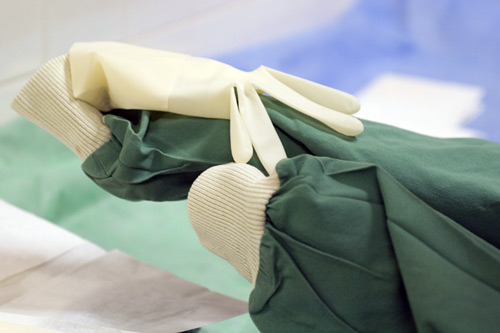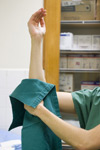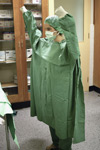Preparation of the Surgeon/Operating Personnel
Unit 2: Sterile Barriers
The final barriers that a surgeon can employ to minimize the potential for contaminating the surgical field is the use of sterile clothing (usually in the form of a surgical gown) and sterile gloves.
Topic 1: Surgical Gowns
Gowns are usually packed with one cotton towel or two paper towels which are used to dry the hands and forearms immediately prior to “gowning up”.
The sterile towel/s are usually placed on top of the sterile gown, therefore to avoid wetting the sterile field with drips of water from the arms, pick up the towel quickly and take a step back from the sterile field.
If paper hand towels are available, use one for one hand and the other for the second hand.
For sterile cotton towels, use one end of the towel to dry the first hand, working carefully up to the wrist, arms and just beyond the elbow without tracking back over any surface.
Utilize the other (dry) end of the towel to dry the second hand and arm.
Discard the towel to a non-sterile surface such as a bench or table or pass it to a non-sterile colleague. (Do not drop towels onto the floor)
Gowns are a sterile barrier between the skin of the surgeon and the patient.
Surgical gowns should ideally be made of a material that acts as a barrier to the passage of microbes, is resistant to blood and fluids and is free of lint.
Disposable single use gowns have superior barrier properties and are the surgical gown of choice, although cotton reusable gowns are still used in some smaller veterinary practices.
The material should be resistant to penetration by blood, fluids, be low-linting, durable and resistant to puncture or tears. Surgical procedures that may have little to no blood exposure may utilise a minimal barrier gown, whilst gowns with a higher level barrier would be utilised where reasonable blood or fluid spillage may occur.
The material should retain its integrity throughout the surgical procedure and be appropriate to the method of sterilization used.
Gowns and drapes should be free of holes and tears. Where holes exist, a patch may be heat sealed but not sewn on, as needle holes reduces the barrier effect of the material.
If reusable materials are selected then these should be treated with a chemical protective layer. Manufacturer’s advice should be sought for the number of launderings this material can withstand before discarding.
These cloth gowns however lose all their barrier properties when wet.
Topic 2: Surgical Gloves
Gloves are a sterile barrier between the hands of the surgeon and the patient.
The use of sterile gloves should not however be seen as a substitute to proper skin scrubbing as they are frequently perforated during the surgical procedure.

Up to 50% of surgical gloves contain holes at the completion of surgery and this may increase with long or difficult procedures.
Gloves were first introduced into surgery by Halsted in 1890, to protect his hands from the patient!
Gloving can be performed by one of 3 techniques:
Surgeons should be proficient in the closed and open techniques.
- Open
- Closed
- Assisted
 |
Click on the link to view open and assisted gloving
 Link to download Surgical Operational procedure - pdf (495Kb)
Link to download Surgical Operational procedure - pdf (495Kb)


